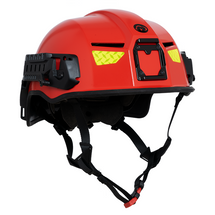Posted by Keith J - Tactical Solutions on 4th Aug 2025
Why Helmet Sizing Matters: Reducing Injury Risk Through Proper Fit
When it comes to protective equipment in frontline emergency services, helmet sizing is far more than a comfort issue, it’s a safety imperative. Supplying ill-fitting helmets increases the risk of injury, reduces operational effectiveness, and exposes organisations to legal and reputational risks.
Poor Fit = Increased Injury Risk
Research into anthropometric design confirms that people come in a wide range of head shapes and sizes. The TNO Human Factors Research Institute highlights that using a one-size-fits-all approach in helmet design results in significantly higher “fit errors,” which compromise the protective integrity of the helmet. In fact, moving from one universal size to three or four specific sizes can reduce the average fit error by nearly 50%.
Poorly fitted helmets are more likely to shift during movement, sit incorrectly on the skull, or create pressure points that cause distraction, discomfort, and long-term musculoskeletal strain. In high-risk scenarios such as rescue, firefighting, or ambulance response, that’s not just inconvenient, it’s dangerous.
A Diverse Workforce Demands Diverse Sizing
Gender diversity in Australia’s emergency services continues to rise, and rightly so. In the Queensland Ambulance Service (QAS), women now represent a significant portion of the workforce. National figures from the Council of Ambulance Authorities indicate that over 50% of ambulance service personnel in Australia and New Zealand are women.
Despite this progress, PPE design often lags behind. Historically, many PPE systems, including helmets, were designed around male anthropometry. But with smaller average head circumference, length, and breadth, female personnel frequently struggle to find helmets that fit securely and comfortably. A system that doesn't accommodate these differences risks compromising both safety and inclusion.
The Busch PROtective ATR-1 Helmet, for example, offers a practical solution coming in three distinct shell sizes (H1: 48–56 cm, H2: 54–62 cm, H3: 58–66 cm). This range supports a proper anatomical fit for a broad spectrum of users, regardless of gender or head shape.
Legal and Organisational Risk
Under Australia’s Work Health and Safety Act 2011, organisations have a duty of care to ensure that all provided personal protective equipment (PPE) is:
- Suitable for the nature of the work
- Properly fitted to the individual, and
- Maintained to ensure its effectiveness
Failure to do so may constitute a breach of these obligations. If a staff member sustains an injury that could be reasonably linked to inappropriate or ill-fitting PPE, the organisation may be held liable for negligence and could also face enforcement action under WHS laws.
From a legal standpoint, supplying "standard issue" PPE without regard for individual fit can be risky, particularly when alternative sizes or more appropriate equipment exist. From a leadership standpoint, it's also counterproductive: it damages morale, undermines trust, and sends the message that convenience trumps care.
Sizing Options Are a Smart Investment
Organisations that invest in a wider range of helmet sizes and proper fit testing benefit in several ways:
- Reduced injury and claims risk
- Increased staff comfort and compliance
- Stronger alignment with WHS obligations
- Improved retention and satisfaction across a diverse workforce
In other words, offering helmets in multiple sizes isn’t just a box-ticking exercise, it’s a tangible way to protect your team, fulfil legal duties, and lead by example.
Final Thoughts
As Australia’s broader emergency services continue to evolve into more diverse and inclusive organisations, PPE must evolve with them. Helmet sizing is one simple but powerful area where we can reduce preventable risk and enhance the safety and performance of those who protect our communities every day.
One size does not fit all. And when lives are on the line, fit matters.

